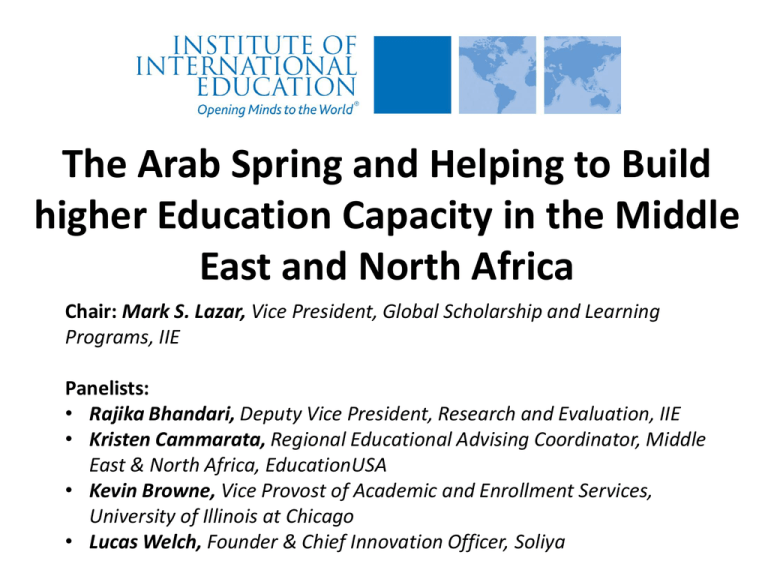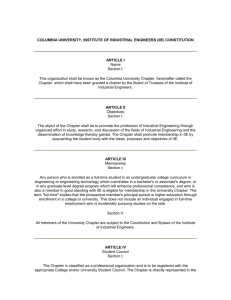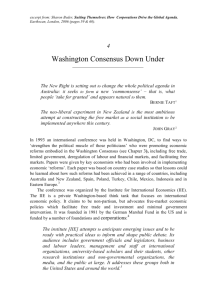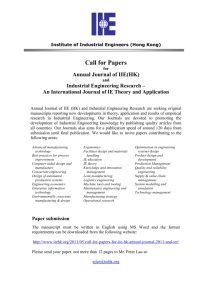View presentation - Institute of International Education
advertisement

The Arab Spring and Helping to Build higher Education Capacity in the Middle East and North Africa Chair: Mark S. Lazar, Vice President, Global Scholarship and Learning Programs, IIE Panelists: • Rajika Bhandari, Deputy Vice President, Research and Evaluation, IIE • Kristen Cammarata, Regional Educational Advising Coordinator, Middle East & North Africa, EducationUSA • Kevin Browne, Vice Provost of Academic and Enrollment Services, University of Illinois at Chicago • Lucas Welch, Founder & Chief Innovation Officer, Soliya Classifying Higher Education in the Middle East and North Africa: A Pilot Study Rajika Bhandari Deputy Vice President, Research and Evaluation Center for Academic Mobility Research Institute of International Education March 8, 2012 Why develop a classification? • Higher education sector has witnessed tremendous growth • No standardized framework for understanding the region’s institutions • Many countries have established these types of classifications and rankings to raise the quality and visibility of their higher education sector • The Arab Spring and higher education in the region Intended Outcomes • Deeper understanding of the diverse range of institutions in the region • Within region: benchmarking and comparison; increased research collaboration & exchange • Outside the region: institutions able to compete globally and position themselves on the world stage; expanded international collaboration • Information available to guide students • Increased degree recognition and academic mobility Study Design • Supported by the Carnegie Corporation, carried out in partnership with LAES • Pilot study countries: Egypt, Jordan, Lebanon, Morocco, Qatar, Saudi Arabia, Tunisia, UAE • Primary and secondary data from ministries and higher education institutions (HEIs) • Sample size: originally 643 institutions; final sample, 427 • Timeframe: March 2010 – March 2011 Methodology • Reviewed existing classifications and rankings systems • 11 dimensions, 77 indicators • Developed and pilot-tested survey to validate the CMAC • National-level data coordinators in each pilot country • Outcome: validated and tested CMAC scaled up and applied to other countries comprehensive classification of higher education in the region Dimensions of the CMAC # Dimension 0 1 2 3 4 5 6 7 8 9 10 Institutional profile Teaching and Learning Profile (Co) Curriculum Student Profile (Co) Faculty Profile Financial Profile Research Involvement (Co) Cultural Orientation Religious Orientation Regional Engagement (Eu) International Engagement (Eu) Number of Indicators 8 7 3 7 7 7 9 3 6 7 13 Examples of Indicators 6. Research Involvement 10. International Engagement 6.1 6.2 6.3 6.4 10.1 10.2 10.3 Expenditures on research Publications Research centers Libraries International students International sources of income Graduate students on out-bound exchange programs 10.4 10.5 Incoming grad students with degrees from other institutions International teaching and research staff 10.6 10.7 Twinning with international HEIs International admission tests 10.8 10.9 Cooperation agreements with international HEIs Affiliation to international institution/branch 10.10 10.11 10.12 Intended international engagement Accreditation Organization of international engagement Findings: International Engagement • What do we mean by “international”? • Mobility: • Only 2% of all students are international (0 to 80%); 4.3% are from other Arab countries • 11% of the teaching staff is international; 13% are from other Arab countries • There is a larger presence of foreign faculty than foreign students. Findings: International Engagement • There appears to be more international engagement than regional engagement: twinning programs and cooperative agreements • There are key differences by sub-region: Gulf nations vs. other countries • Incomplete measurement, missing data Overall Findings • Lack of institutional data • Shifting cultural models: French (45%), American (43%) • Low regional and international engagement • Use of English for administration and teaching • Impact of branch campuses • Investments in research Challenges • Obtaining buy-in from ministries and HEIs • Summarizing data across multiple campuses is difficult • Challenges inherent in generalizing across diverse countries and education systems Looking Ahead • Significant interest in expanding the work of the pilot study • Capacity-building in the region • Engage other countries that have strategically used classifications and rankings to strengthen the quality of their higher education systems • Is a ranking currently feasible? Not yet. We have a good framework in place, but better and more complete data is needed to compile rankings that are accurate and fair. • Higher education and the Arab Spring iie.org/opendoors Data on academic mobility to and from the U.S. www.iie.org/mobility Center for Academic Mobility Research facebook.com/IIEglobal Latest updates on IIE news & events twitter.com/IIEglobal Quick alerts on international education news & trends iienetwork.org Resources for international education professionals www.iie.org Information on IIE programs & services The Arab Spring and Helping to Build higher Education Capacity in the Middle East and North Africa Chair: Mark S. Lazar, Vice President, Global Scholarship and Learning Programs, IIE Panelists: • Rajika Bhandari, Deputy Vice President, Research and Evaluation, IIE • Kristen Cammarata, Regional Educational Advising Coordinator, Middle East & North Africa, EducationUSA • Kevin Browne, Vice Provost of Academic and Enrollment Services, University of Illinois at Chicago • Lucas Welch, Founder & Chief Innovation Officer, Soliya
![IIE Continuing Education Benefits You and Your Company[1]](http://s3.studylib.net/store/data/007679605_2-bb634887790654c6045e40acc116701d-300x300.png)






